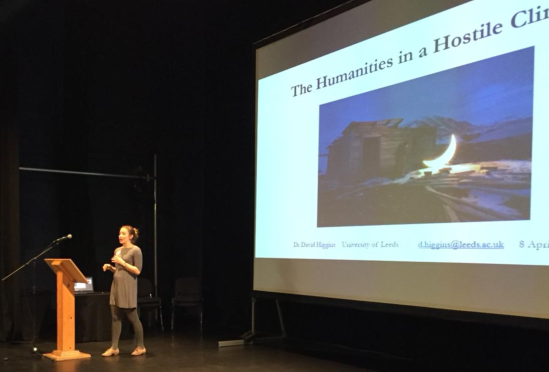A Hostile Climate? Insights from a multidisciplinary conference

The overwhelming majority of climate scientists agree that we are fast approaching (or have already passed, in some cases) the edge of climate change: the threshold at which the runaway effects of anthropogenic emissions will prevent any meaningful attempts to mitigate the consequences for life on Earth. It is widely acknowledged that an average temperature increase above 2 degrees centigrade will be catastrophic for humanity and the biodiversity of the planet, and this was confirmed by the IPCC Special Report on Global Warming of 1.5°C.
How to implement significant changes in industry, lifestyles and society in order to predict or prepare for its effects on those most at risk was one of the many questions that young academics and artists attempted to answer at a new one-day conference at The University of Leeds. ‘A Hostile Climate? Multidisciplinary Perspectives on Climate Change’, held on 8 April 2019, encouraged postgraduate and early career researchers to interrogate and respond to the meaning of ‘hostile climates’ in diverse and receptive ways, bringing together scholars from across the humanities, sciences and beyond.
After an illuminating opening talk from Dr David Higgins (School of English, University of Leeds) on ‘The Humanities in a Hostile Climate’, exploring how the humanities can contribute to climate solutions, the event was divided into four panels. The first panel, ‘Climate Change and Human Perceptions’, explored the varying ways in which people perceive and react to climate change. Discussions covered the common presence of emotions such as guilt, fear, and grief, to the loss of natural environments, and the use of media such as paintings, drawings, poetry, diaries, and newspapers in society’s perception of the climate conversation.
The second panel, ‘The Future of Change’, examined new and innovative approaches to climate change adaptation and mitigation. With talks such as ‘The importance of the rule-breakers’ (Manda Brookman, University of Bristol) and, ‘Can virtual reality catalyse pro-environmental behaviour change?’ (Catherine Graves, University of Leeds), this covered the potential for new technologies and new mediums to facilitate participatory climate adaptation, communicate climate change and influence pro-environmental behaviour.
‘A Hostile Climate?’ also explored our relationship with Earth’s climate through the medium of art. Five exhibiting artists displayed examples of their work relating to climate change issues, through sculptures highlighting rising sea levels, plastic in the oceans, and the concept of the Anthropocene (Jacqui Jones, Norwich University of the Arts; Benjamin Allen, University of Leeds), paintings inspired by rising temperatures and humanity’s relationship with the environment (Isaac Heard, Lancaster University; Crowley Zwartjes, Leeds Arts University), and photography to communicate the responsibility and determination of people to enact positive environmental change (Natalie Lee, Layla Hendow and Yasmine Akin, Invisible Dust).
Two further panels continued the conversation, bridging the gaps between disciplines. The third panel, ‘Global Voices in Hostile Environments’, focused on the less audible voices within climate discussions, such as indigenous or marginalised peoples, and those most frequently exposed to the hostile environments, both physically and socially. Talks in this panel explored the ways that different groups are typically portrayed within climate discourse, how those groups conceptualise natural disasters, and the impact of climate change on traditional lifestyles.
The fourth and final panel, ‘Environmental Legacies’, investigated the wide-ranging implications of human activity on the geological and ecological record, the demands for reparative justice for affected peoples, and how creative performances may be used to communicate climate change into the future.
The conference closed with a keynote speech by Dr Katy Roelich (School of Earth & Environment/School of Civil Engineering/Priestley Centre, University of Leeds), who spoke on the importance of public involvement in civil planning schemes, particularly those with the intention of improving the environmental impact of an area.
This event aimed to uncover and create new connections between young artists and researchers from otherwise disparate disciplines, whose only previous link might have been an interest in climate change phenomena. The climate solution conversation is one that will require unity and collaboration across a new generation of scientists, activists, and humanitarians.
The conference was made possible through joint co-funding by the School of Geography at the University of Leeds, the White Rose College of the Arts & Humanities, and Invisible Dust, a charity that combines art and science to raise awareness of environmental issues. It was organised by postgraduate researchers and Invisible Dust Fellows, Isabel Cook (University of Sheffield), Claire Cooper (University of Leeds), Rosamund Portus (University of York), and Lucy Rowland (University of Leeds).
Claire Cooper, Priestley PhD researcher
Image: Isabel Cook of the University of Sheffield opens ‘A Hostile Climate?’
